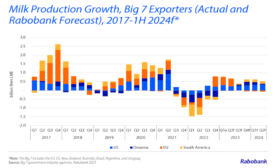Home » Keywords: » exports
Items Tagged with 'exports'
ARTICLES
Opportunity abounds for U.S. dairy proteins in Southeast Asia
USDEC programming in Singapore promotes protein quality and spurs innovation.
January 2, 2024
State of the Dairy Industry: Lower dairy prices should drive global demand
Southeast Asia exports should grow
November 29, 2023
Everything to know before exporting to China
This includes multiple steps, including adhering to recently announced new decrees.
July 28, 2023
2022 a record-breaking year for U.S. exports
Dairy processors continue to excel in this category despite major headwinds.
April 7, 2023
Rabobank report: Participants in the dairy value chain are being "squeezed"
Greater year-on-year milk production growth has emerged in 2023 in the key export regions, compared to 2022’s low levels, report adds.
March 8, 2023
2022 State of the Industry: Dairy exports running low on jet fuel
The future looks bright however.
November 9, 2022
DairyAmerica Honored as U.S. Dairy Exporter of the Year
Company honored for its great supply-chain efforts, plus much more.
October 31, 2022
Stay ahead of the curve. Unlock a dose of cutting-edge insights.
Receive our premium content directly to your inbox.
SIGN-UP TODAYCopyright ©2024. All Rights Reserved BNP Media.
Design, CMS, Hosting & Web Development :: ePublishing


.png?height=168&t=1703091340&width=275)










